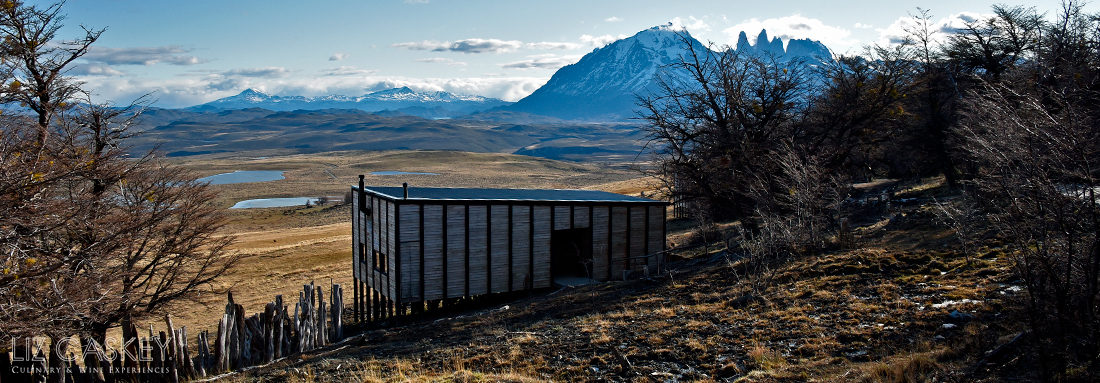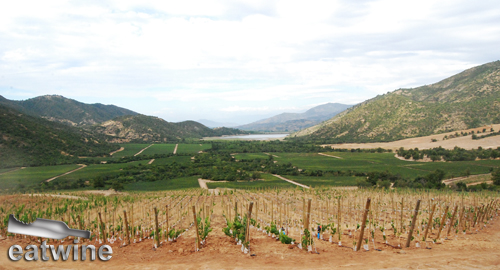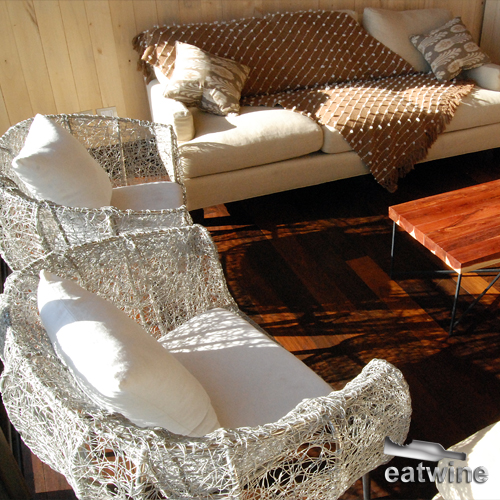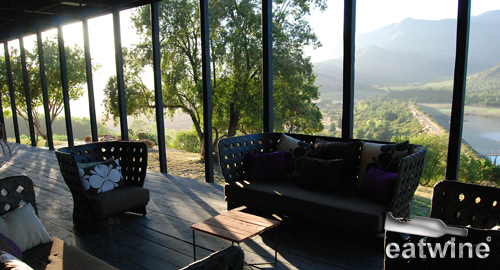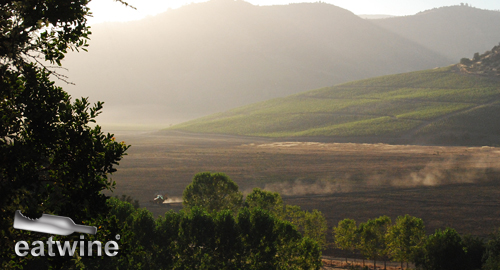I am in the front seat of a 4×4 bouncing up a very steep road cut out of a tree-entangled hillside. A cloud of terracotta-colored dust fills the air, forcing up to shut the windows. To my left, expertly navigating these unruly roads, is a soft-spoken man, the passionate force de vie, behind this innovative, new wine project in the central Cachapoal Valley. Meet Patrick Valette and Viña Vik.
We stop at the highest point to survey their 4,325 hectares (10,688 acres) valley. Below, the folded mountains encase the meticulously-kept vineyards carpeting the floor and hillsides. In the distance, the snow-capped Andes jaggedly punch up into the sky. We look to the south and west over Colchagua, Cachapoal’s neighbors. Below, we have a hawk’s view of the four tiny casitas of Casa Lapostolle’s chic lodge and Montes winery.
Viña Vik is, in a word, astonishing. No detail, nor expense, has been spared in this project. There is no other project of this scale nor ambition in South America: sheer acreage, viticulture, depth, architecture, and financial shoulders. The brainchild of Norwegian billionaire Alexander Vik, owner of the exquisite Vik retreats in José Ignacio, Uruguay, although the project began in 2004, it took Patrick and his team nearly 2 years to locate the property, which would become home for the Vik vineyard. They settled on the land in Millahue, which fittingly means, “place of gold”, in the native Mapudungun language.
As Patrick explains the Vik concept, it is clear that science, technology, and knowledge are the base of everything and how they made their decisions on where to plant; not any easy feat with so many options. Extensive soil studies were carried out to determine the ideal location and microclimates for planting the five red varietals of Cabernet Sauvignon, Carmenere, Syrah, Cabernet Franc, and Merlot. That currently has translated to twelve, yes 12, different micro valleys, each with unique types of soil that were analyzed to determine the best plantstock.
Patrick explains that while they determined the terroir was excellent (that is the canvas, so to speak), it can only give you so much. The next step is understanding viticulture and how to coax the best expression of the land through the grapes, and ultimately wine. Vik now has 303 planted hectares (748 acres). There is constant concern for the balance between the land, plant, rootstock, and weather conditions. As such a lot of attention is given to pruning and thinning the crop as necessary to achieve those beautiful grapes that become the base for Vik’s fine wine.
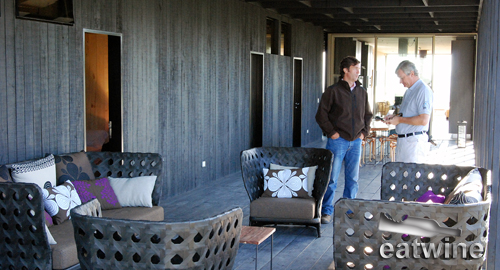
One thing that immediately jumped out at me—the density of plants per acre. In Chile, unlike Europe, there is a lot of room to plant and agriculture has been much more dominated by mechanization, and the width of rows in vineyards has typically been dictated by the size of tractors and other equipment used to work the vineyard. As such, densities can range from 1,000 to 3,000 per hectare. To give you a reference, in the finer wine regions of France, like Burgundy, everything in making the wine was done by hand. When vineyards were replanted after phylloxera, spacing between rows was often just sufficient for humans, and horses, to pass through. The great terroirs of Burgundy, and St. Emilion in Bordeaux, are a precious commodity, and as such, they try to get as much fine fruit as they can from the small amount of acreage they have. Thus, vineyards in Burgundy, Bordeaux, and Champagne can have up to10,000 vines per hectare, with vines spaced about one meter apart within/between rows. At Vik, they are hitting those high-density plantations of 7,500 plants per hectare on floor and 8,300 plants on the steep hillsides.
Why? The vines grown in this fashion yield smaller berries and smaller clusters, so it takes more vines to generate pounds of fruit and you get an ideal concentration of aromas, flavors, and tannins. In the field, Patrick and his team also prune in guyot; debud in September to select best buds (from where the clusters will be born; thin in December to select best clusters; and remove leaves for better air. All of this is to create the best quality grapes with amazingly intense flavors and tannins.
The sun begins to lay low in the western horizon and we return to the valley floor. The resident arriero has saddled up their criolla horses so we set out to see the large clearing that will be the future winery’s site. I mount a mahogany-colored petit yegua called Guinda (Cherry) with a sparkplug personality. As we pass the cherry and almond orchards, also on the property, I have to hold the reins tight so she won’t burst into a full gallop.
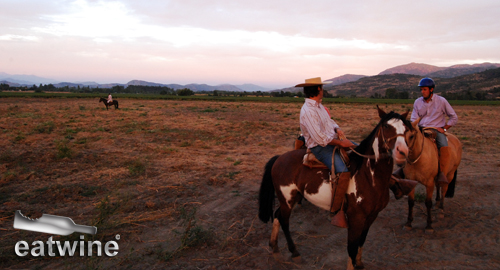
That night, we stay over as guests at the private lodge with sweeping views of the valley and reservoir below. We savor lemony pisco sours on the terrace with Patrick and his wife, and team members Gonzague de Lambert and Cristián Vallejo, followed by a delicious pastel de choclo. The night time is cool and fresh and silence reigns.
The next morning we awake in our suite to the sun reflecting on off the azure reservoir and queltehues cawing in the distance. The sounds of the Chilean countryside. After breakfast, Patrick returns to Santiago and we stay on to meet Cristián in the makeshift winery with stainless steel tanks huddled under a large galpón. Refrigerated truck containers are holding the precious barrels full of Vik’s 2009 vintage. We enter into another barrel room where we taste a selection of 2010 barrel samples of the components that go into the blend: Cabernet Sauvignon, Syrah, Merlot. The Cab is killer and it’s hard to believe it is so smooth, round, and young. The Syrah is like a bowl of ultra ripe blackberries with tinges of pepper and cloves. The wines are marked by notes of fresh, lush fruit and in the mouth, have a velvety texture that is long, persistent, and harmonious.
Vik 2009, which we taste, is not yet on the market (looking at early 2012 for launch). They are selling “futures” and I recommend getting in on this first vintage since it will be a reference for any collector in the future. You can order here. Back to the wine. The 2009 vintage is a blend of 63 % Carmenere (the signature grape of Chile), 34 % Cabernet Sauvignon, 2% Cabernet Franc and 1 % Syrah. The wine looks like ink in the glass—so purple its black. Even before bringing the glass close to the nose, the fresh fruit aromas explode from the glass—cherry, strawberry, and plum. In the mouth, the wine is remarkable. Considerable structure (read: tannins), yet rounded out with good acidity to push those fruit flavors through. There’s a note of minerality, and the finish goes on. And on. And on. It’s defined yet muscular. Strong but not overbearing. Freshness and elegance rule. I cannot imagine how amazing this wine will be once it’s finished aging and then, for those with patience, let it evolve over the next decade. A true legend in the making.
All of the effort and passion that have gone into transforming this corner of the Chilean countryside is expressed in this wine. While there’s some debate as to if terroir can be “created” by planting new vines, in the case of Vik, I see their unique terroir as a harmonious, beautiful melding of the land’s potential, their team’s effervescent energy and focus, the workers’ enthusiasm, and even the transformation of the tiny Millahue village. They all have come together to realize one dream because they truly believe in it: the Vik wine. This is like witnessing a baby being born. Only in the years to come will this project mature and develop into its full expression and true potential. Just like we do as human beings as we come into our consciousness. Keep an eye on Vik. It may sound ambitious first but trust me, its heart, and vines, are in the right place.
To visit Viña Vik and experience their private guest lodge contact us to include in one of our private wine tour programs.
